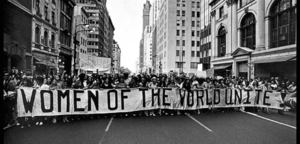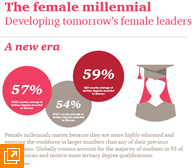UBC Wiki:GRSJ224/Postfeminism
The Post Feminism era "the third wave" By: Danielle M
This Wiki Page explores the three stages of feminism, specifically focusing on the third and current stage; Post Feminism. It will also focus on the impact the stages have had on the general perception of feminism. By looking at all of the events leading up to this Post Feministic era including the First World War, Second World War, Work force shifts and domestic household shifts, we can see it is obvious that women are slowly gaining economic and political power. Michelle Moravec emphasizes this journey in "Toward a History of Feminism, Art, and Social Movements in the United States" (2012): [1] "as of 1971 there is no comprehensive set of beliefs which can accurately be labeled women’s liberationist, feminist, neofeminist or radical feminist ideology".
Introduction
Feminism is defined by the advocacy of rights based on the equality of sexes, and Feminist theory is an extension of feminism into fictional, theoretical or philosophical discourse.
History
History of Women https://www.youtube.com/watch?v=Xrp0zJZu0a4
First, during World War I few women in Canada were then allowed to vote, later in 1919 women 21 & over had the right to vote in federal elections. [2] Since 1870 women’s suffrage groups were working towards the right to vote. Simultaneously women’s rights were diffusing into legislation around the world. [3]
first wave
The first wave of feminism in Western Society came from the leadership of women and their desideratum for the right to vote. Politics had always been and still is a game of power and control. Women slowly realized that they needed independence and equality,“The political agenda expanded to issues concerning sexual, reproductive and economic matters. The seed was planted that women have the potential to contribute just as much if not more than men.” [4] Women as activists lead the charge on all things change and different. This was the start of feminist theory.
second wave
The second wave of feminism began during World War II. the female demographic in Canada and the United States started to enter the workplace, this allowed for women to strengthen their presence in the workplace. Women continued fighting for their civil rights, specifically reproductive rights. Women met their second wave goals of equality, not including the failure of the Equal Rights Amendment ratification. [5] During this time there were multiple groups emerging and fighting for equality, this created a agglomerate of groups fighting and therefore not having a chance to further their movement . Gender equality became a binding issue that was vital to guarantee their voices were heard. [6]
third wave
The third wave started in 1990 and is still evolving today. Defining the third wave has been a challenging task because it involves the micro politics of gender equality. There has been immense progress since the first wave in WWI. The word 'feminism' continued to be broadened; men began using the word feminist to classify themselves. Because of the scrutiny that feminism as a word underwent, this was a turning point for the post-feministic world. Still, equality in the workplace is an ongoing issue; women are constantly fighting for equal pay, maternity leave and against sexual harassment. Leading into the 21st century medicalization, the work place and domestic work continue to develop.
The Twenty First Century
medicalization
During the second wave women started the journey for full control of their bodies. Women wanted the full rights to abortion whilst many were fighting directly against these rights. Civil rights are put in place to protect individuals against others and to protect individual’s freedoms. Civil rights are very close to feminist ideals in different ways, and very instrumental when it comes to abortion rights. In 1988 prior to the Charter of Rights and Freedoms [7] abortion became legal at all stages of pregnancy, due to the unconstitutional nature of Pro life campaigns. In Canada, abortion and the technology surrounding it is progressing but in other countries such as the United States many women are still fighting for the rights to their own bodies. Abortion is legal in the United States but do to the formatting of congress and states individual power, some regulate and limit abortion. [8]
work place
During the first wave, once women had the right to vote women were strengthening the economy and gaining their place in the work force. Although this was a leg up for women, it is an ongoing issue and one that may not ever be full resolved. This is a form of on going oppression and capitalism, many companies and corporations want men to fast track CEO positions while women take care of the children. Women often have to fight for the chance to show their capabilities. Essentially this goes hand in hand with the glass-ceiling concept, women can only reach a certain rank and there is no more promotions after that. [9] Through statistics Canada we can see an overall positive linear trend of women joining the work force. [10]
home sphere
Women have always been the homemakers, earlier in the 18th and 19th century it was paradigmatic for women to become mothers and for the men to provide for the family. Although this has developed through time, women still face discrimination. Often because of the maternal instincts of a woman it leads to them being the caregiver but through women’s economic role expanding it has been the main impetus for eroding the cultural idea that men should be responsible for paid work while women take care of unpaid household and family duties. [11] Statistics Canada shows us that even when neither couple is working women do 23 more hours per week of work. [12]
Conclusion
In conclusion, all of these events over arch the grasp versus the physical reach of women’s rights and ideals in the 20th and 21st century that will be forever evolving. There is such a large variety of definitions for feminism today that is it too difficult to label any one person as a feminist. Although, this reference from Kate Stapleton [13] is quite compelling, “Your really modern women is essentially independent, from the tips of her painted finger-nails to the last curl of her perm. Her most devastating weapon today lies in the jungle of her weekly salary, which tells her boyfriend that he can’t keep her quite at his personal beck and call as in the old days”. [14] It is important for us to illuminate history with women in it.
References
- ↑ Moravec, M. (2012). Toward a History of Feminism, Art, and Social Movements in the United States. University of Nebraska Press. Accessed: 05-04-2017 http://www.jstor.org/stable/pdf/10.5250/fronjwomestud.33.2.0022.pdf
- ↑ Women Get the Vote 1916-1919. World War I. http://www.canadahistoryproject.ca/1914/1914-08-women-vote.html
- ↑ Moravec, M. (2012). Toward a History of Feminism, Art, and Social Movements in the United States. University of Nebraska Press. Accessed: 05-04-2017 http://www.jstor.org/stable/pdf/10.5250/fronjwomestud.33.2.0022.pdf
- ↑ Dorey-Stein, C. (2015). A Brief History: The Three Waves of Feminism. Retrieved from https://www.progressivewomensleadership.com/a-brief-history-the-three-waves-of-feminism/
- ↑ Dorey-Stein, C. (2015). A Brief History: The Three Waves of Feminism. Retrieved from https://www.progressivewomensleadership.com/a-brief-history-the-three-waves-of-feminism/
- ↑ Dorey-Stein, C. (2015). A Brief History: The Three Waves of Feminism. Retrieved from https://www.progressivewomensleadership.com/a-brief-history-the-three-waves-of-feminism/
- ↑ National Abortion Federation. Legal Abortion In Canada. Retrieved from http://www.nafcanada.org/legal-abortion-ca.html
- ↑ Ravitz, J. (2016). The surprising history of abortion in the United States. CNN. Retrieved from http://www.cnn.com/2016/06/23/health/abortion-history-in-united-states/
- ↑ Morrison. A.M., White, R.P. , Van Velsor, E. (1994). Breaking the Glass Ceiling: Can women Reach the Top of Americas Largest Corporations
- ↑ http://wiki.ubc.ca/File:Work_place_stats_table.docx#file
- ↑ Marshall, K. (2006). Perspectives on Labour and Income. Ottawa. http://search.proquest.com/openview/79a6ee8d50f0cae01358c3af30ee37e9/1?pq-origsite=gscholar&cbl=44493
- ↑ http://wiki.ubc.ca/File:Home_sphere.docx
- ↑ Stapleton, K. (2011). Glamour: Women, History, Feminism. The Journal of Popular Culture. Vol. 44, Issue Blackwell Publishing Inc. 10.1111/j.1540-5931.2010.00826_6.x
- ↑ Stapleton, K. (2011). Glamour: Women, History, Feminism. The Journal of Popular Culture. Vol. 44, Issue Blackwell Publishing Inc. 10.1111/j.1540-5931.2010.00826_6.x


